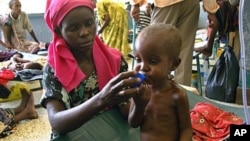Somalis trying to escape drought and famine continue to flock to Mogadishu, despite renewed fighting between pro-government forces and the militant group al-Shabab. Many of those going to the capital had fled the city months and years earlier to escape the fighting.
Desperate search for food and water
“In Mogadishu, we’ve been concerned because more than 100,000 Somalis have recently moved into the city in search of food, basically. These are people who are coming from areas in the south and central part of Somalia, where many of those areas have now been officially declared famine areas,” Ron Redmond, spokesman for UNHCR, the U.N. refugee agency, who’s in Nairobi.
To risk coming to an embattled city is a telling sign.
“Mogadishu itself is probably the most dangerous city in the world. The security situation there is extremely bad,” he said.
There are some food stocks in the city that are being distributed by local charities.
“The head of our Somalia operation was in a district just west of Mogadishu,” said Redmond, “and a local charity was handing out food and basically a riot ensued where there was too little food and too many people.”
Coming home
Many of those arriving in Mogadishu used to call the city home.
“Most of the internally displaced in that region left Mogadishu are living in a corridor about 30 miles to the west of Mogadishu called Afgooye. And there are something like 400,000 people, who fled Mogadishu to get help out there. Now you’ve got a hundred thousand people from elsewhere going into Mogadishu because they are so desperate to get assistance.
UNHCR has been distributing supplies within and around Mogadishu. But it hasn’t been easy.
“Some supplies can get into Mogadishu. The situation there though is that it is so insecure. The area that our Somalia operation representative visited the other day was only 500 meters from the front lines. And there were thousands of people there jostling to get food. Getting it out there and getting it distributed around the city is the problem. It’s just so dangerous and so difficult to operate there,” said Redmond.
UNHCR is sending assessment teams around the country to determine the scope of the aid needed.
Outside Somalia
People displaced in Somalia often become refugees in neighboring countries.
“The numbers of people arriving in both Kenya and Ethiopia from Somalia is continuing at a pretty steady pace. Right now in Ethiopia’s Dollo Ado area, we’re seeing about 300 people a day arriving. That’s down from about 2,000 three or four weeks ago. We don’t know the reasons for that. But they’re coming in in a very bad state,” he said.
The malnutrition figures for children are alarming.
“About one out of three children are suffering from severe acute malnutrition, which is terrible. One of our nutritionists there said that she hasn’t seen this kind of rate in her 20 year career in and around the Horn of Africa. Even more worrisome she said is that there is a 5 to 18 year old age group and within that group she’s never seen such a high incidence of malnutrition either. Usually, it’s the under fives that are severely affected,” he said.
Redmond said at Kenya’s Dadaab refugee camp, about 1 in 4 under five year olds are coming across severely malnourished.
About 1,300 people a day are arriving at Dadaab. “We are sending people to the outskirts of the camp to identify the malnutrition cases and get help to them because the camp is so packed that all the new arrivals are staying on the outskirts of the camp,” he said.
Need more land
The Dadaab complex was built to hold 90,000 people, but estimates say there are now 350,000 to 400,000 people there. That overcrowding has prompted Human Rights Watch (HRW) to call on the Kenyan government to provide more land for new camps and to open an existing, but unused, camp for the Somalis.
“There currently is not enough space for the large number of Somali refugees that are pouring into Kenya,” said Neela Ghoshal, HRW’s East Africa researcher, adding, “For several years, the existing refugee camps have been far beyond capacity. And yet the Kenyan government has refused to provide additional lands to build refugee camps, despite promises from donors that they would be willing to fund these refugee camps.”
She said the Kenyan government does have some legitimate concerns, including security and environmental concerns.
“We understand these concerns. But we want to emphasize that these concerns don’t detract from the responsibility of the Kenyan government to permit legitimate asylum seekers to enter Kenya,” said Ghoshal.
Human Rights Watch has requested numerous times that Kenyan officials open up a section of the Dadaab complex that has been available since last November, but remains unused.
“The camp is called Ifo and the extension is known as Ifo Extension or Ifo II. It’s a camp that, according to UNHCR, would fit 40,000 additional refugees. According to the government, it would fit 80,000. However, even if that camp was built, there are currently over 390,000 Somali refugees and asylum seekers in a space that is built for 90, 000,” she said.
Even if IFO II is opened, she said, it still wouldn’t be enough. She said donors are willing to pay for more camps.
“We’d like to see the Kenyan government go ahead and accept that additional refugee camps be built and then call on donors and the UNHCR to provide those refugee camps,” she said.
Other land in northeastern Kenya may be suitable for the camps.
“We know that there’s an additional piece of land in northeastern province near Dadaab,” Ghoshal said, “and this space has been identified by UNHCR, at least as far back as a year and a half ago,” she said.











